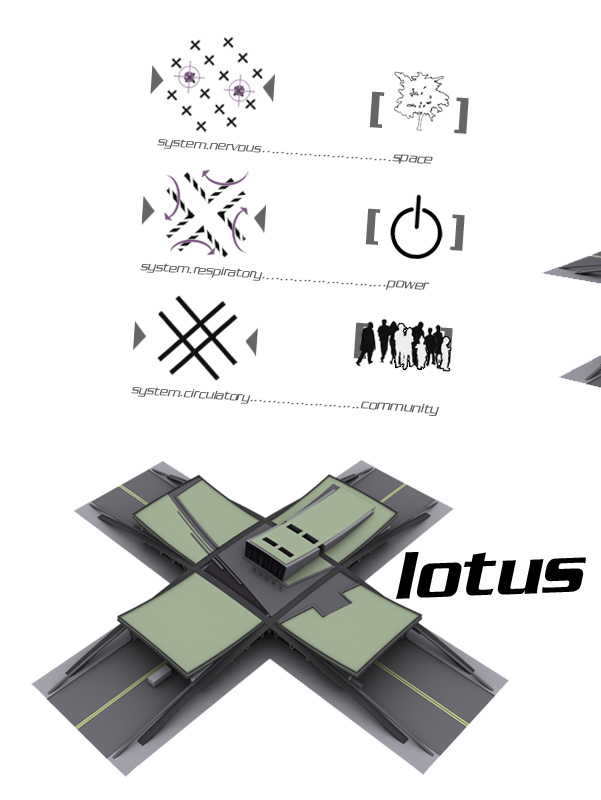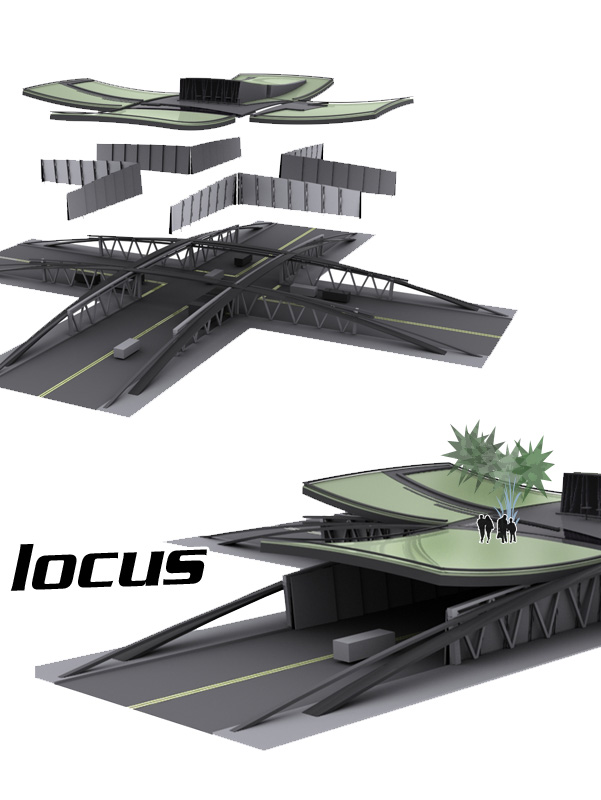
lotus locus by dan selden from usa
designer's own words:
the lotus locus is an infrastructural tool which serves to provide programming opportunities above urban intersections. as the developed world comes to appreciate the beauty of urban environments, many cities are investing heavily in the development and beautification of their urban cores. however, this is often at the expense of peripheral communities and neighborhoods who have been under-served within their own urban environments. granted, open space is not necessarily easy to come by, and the urban core presents the best development opportunities. smaller neighborhoods may lack the space but also typically lack the funding or resources to offer larger cultural districts. with this in mind, the lotus locus was envisioned.
the lotus allows the establishment of a small social hub above busy intersections. at its most basic level, it facilitates more efficient circulation by separating pedestrian activities from that of the street. the space created by these circulational adjustments offers ample opportunity for community development, working closely with the locus to determine the most practical programming strategy. programmatic pads are geared to activate the public sphere in communities where it is absent. the lotus itself can be adjusted to fit the nature of various intersections, both in size and complexity, and like a “plug”, is simply dropped in where needed. various programmatic pads can be phased in later depending on the needs of such communities. the lotus utilizes three systems to help fulfill its role in strengthening urban communities.
as mentioned, the circulatory system allows increased efficiency in traffic circulation as well as providing the infrastructural support for new space.
the respiratory system provides the lotus with its energy. using a gill-like panel system, air currents generated by the movement of traffic are harnessed and stored. this micro-generative power source can feed energy back into the surrounding grid in order to raise money for community events... while providing the energy needed to host such events. by “charging” the space self sufficiency is achieved.
the nervous system provides the intelligence of the lotus, using a expansive grid of accelerometer sensors to monitor its use. this data can be used to efficiently control energy distribution while also providing the raw data for a variety of public open source projects. these projects can range from generative art installations to the studies of urban anthropologists, the work of the creative and the scientific. the presence of the lotus on the web allows a communicative element which will better serve the public sphere, both virtually and physically.
the lotus is a tool. it allows neighborhoods to channel their cultural momentum by providing the space in which to showcase such assets. while a city as a whole may not choose to support such local efforts due to insufficient resources, the purchase of a lotus (imagined as relatively affordable) would allow a greater degree of autonomy among community efforts. community identity is essential to a healthy public sphere as well as its reinforcement of group values. the lotus thus responds to the 21st century in three ways. it promotes economy through development opportunities and micro-generative power creation. through the creation of a self-sufficient infrastructure and the establishment of open space programming, the lotus also strengthens the character of the urban environment. last but not least, the lotus responds to the social elements in our lives, embedding itself within the web while simultaneously pulling people to its physical presence. by providing the resources for community events, it acts to further enhance the vibrancy of an urban neighborhood.
best if viewed next to part II + III
 best if viewed next to part I + III
best if viewed next to part I + III
 best if viewed next to part I + II
best if viewed next to part I + II